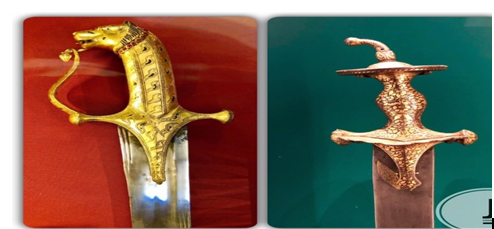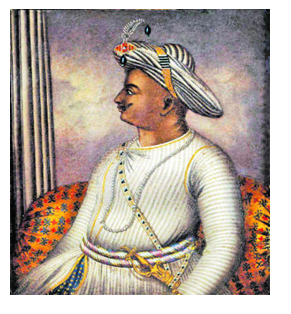

28th October 2023 (9 Topics)
Context
A gem-set and enamelledsword,belonged to Mysore kingTipu Sultan, has gone under the hammer for GBP 100,800 at ‘The Art of the Islamic and Indian World‘saleat Christie’s auction house in London.
About
- The swords previously belonged to Tipu Sultan and have been passed down through the Eliot family since they were presented to Charles, 1st Marquess Cornwallis and 2nd Earl Cornwallis KG PC (1738-1805) in the late 18th century.
|
Charles Cornwallis, 1st Marquess and 2nd Earl Cornwallis (1738-1805), served as a general in the British Army during the American War for Independence, and contributed to establish British authority over India. |
The Art of the Islamic and Indian World ‘auction:
- The auction represents over 500 years of Indian painting, from a 15th-century illustration of ‘Trisala Reclining’ (from a Jain ‘Kalpasutra’) to a work by the contemporary Indian painter Jamini Roy.
- With many lots sold without a reserve price, the sale has been presented as an opportunity for established collectors of Indian paintings or those starting on their collecting journey.
Who was Tipu sultan?
- Tipu Sultan was the son of Haider Ali Khan.
- Haider Ali Khan wrested control of Mysore from the Dalwais, or Commanders-in-Chief, who themselves had already usurped all effective power from the previous Wodeyar king, Chikka Krishna Raj XI.
- Tipu Sultan was born on 01 December 1751 at Devanahalli in present-day Bangalore Rural district.
- He was named "Tipu Sultan" after the saint TipuMastanAulia.
- At age 15, he accompanied his father against the British in the First Mysore Warin 1766. He commanded a corps of cavalry in the invasion of Carnatic in 1767 at age 16.
- He also distinguished himself in the First Anglo-Maratha War of 1775–1779.
- From the age of 17, Tipu was given independent charge of important diplomatic and military missions. He was his father's right arm in the wars from which Hyder Ali emerged as the most powerful ruler of southern India.
His Struggle against the British:
First Anglo-Mysore War (1767-69)
- Tipu Sultan fought alongside his father against the British in the First Anglo-Mysore Warin 1766 when he was 15 years old.
- Tipu Sultan received military training from French officers who worked for his father.
- At the age of 16, he led a cavalry corps in the conquest of Carnatic in 1767.
- He also made a name for himself during the First Anglo-Maratha War,which lasted from 1775 to 1779.
Second Anglo-Mysore War (1780-84)
- The British seized the French-controlled port of Mahe in 1779, which Tipu had protected by supplying troops for its defense.
- Hyder Ali launched an invasion of the Carnatic in response, with the aim of driving the British out of Madras.
- Tipu Sultan successfully reclaimed Chittur from the British in December 1781.
- Tipu Sultan recognized the British as a new form of threat to India.
- By the time Hyder Ali diedon December 6, 1782, Tipu Sultan had acquired sufficient military experience.
- The Treaty of Mangalore, signed in 1784, put an end to the Second Mysore War.
Third Anglo-Mysore War (1790-92)
- On 28th December 1789, Tipu Sultan gathered troops in Coimbatore and launched an assault on Travancore's lines, knowing that Travancorewas a British East India Company ally (according to the Treaty of Mangalore).
- Lord Cornwallisresponded by mobilizing company and British military powers, as well as forming alliances with the Marathas and the Nizam of Hyderabad, in order to defeat Tipu.
- The company forces advanced in 1790, capturing a large portion of the Coimbatore district. Tipu launched a counter-offensive, retaking most of the territory, though the British retained control of Coimbatore.
- In 1791, his adversaries made gains on all fronts, with Cornwallis' main British force capturing Bengaluru and threatening
- Tipu Sultan harassed British supply and communication lines and implemented a scorched earth strategy of refusing the invader's local resources.
- Cornwallis was successful in this last attempt, as a shortage of provisions forced him to retreat to Bengaluru rather than attempt a siege of Srirangapatna.
- He was forced to cede half of his territory to the allies and deliver two of his sons as hostages in the subsequent treaty before he paid the British the three crores and thirty lakhs rupeesset aside as war indemnity for the campaign against him.
- He paid the money in two installments and returned to Madras with his sons.
Fourth Anglo-Mysore War and Death of Tipu Sultan: (1799)
- In 1799, three armies marched into Mysore: one from Bombay and two from the United Kingdom, one of which included Arthur Wellesley.
- During the Fourth Mysore War, they besieged Srirangapatna, the capital.
- The British East India Company had over 26,000 troops, while Tipu Sultan's forces numbered 30,000.
- When the British broke through the city walls, Tipu Sultan was advised to flee through hidden passages by French militaryadvisors, but he declined.
- Tipu Sultan was killed at the Srirangapatna Fort. He was buried at the Gumbaz, next to his father's grave.
More Articles




